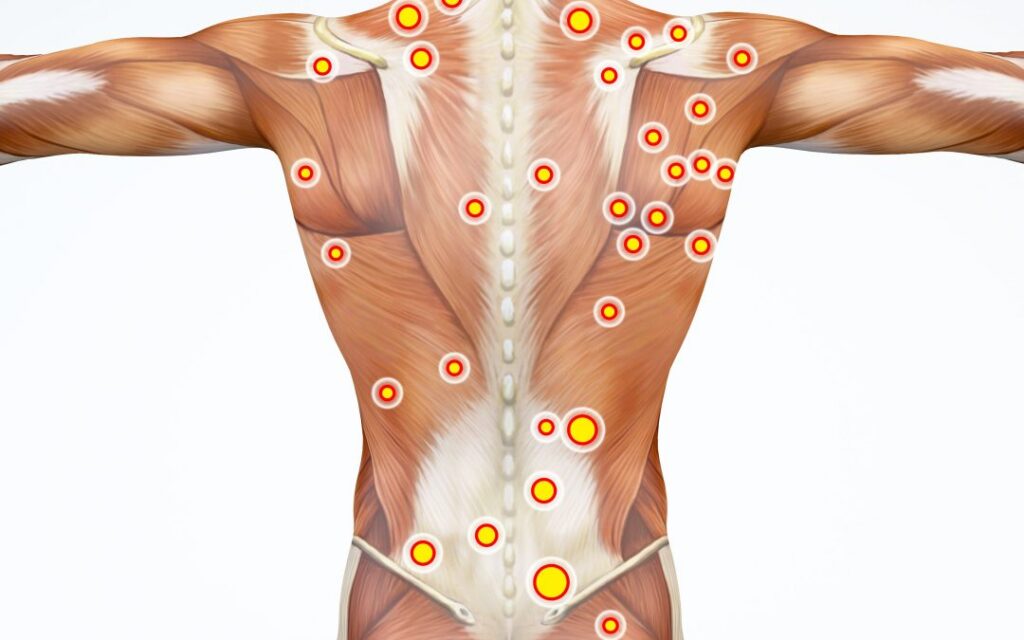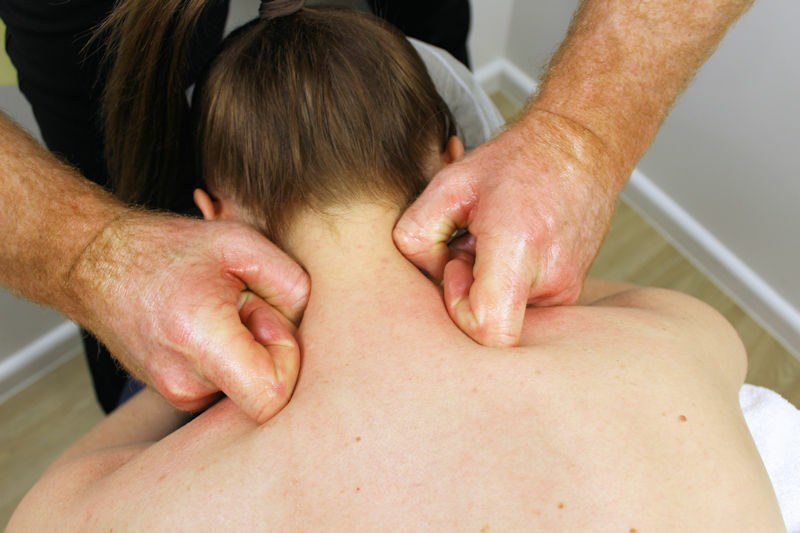Trigger points stand out as tiny yet formidable adversaries, capable of inflicting significant pain and discomfort. These localized areas of muscular tension, often lurking beneath the surface, can disrupt daily activities and diminish quality of life. However, amidst the challenge posed by trigger points, there exists a beacon of hope: trigger point massage therapy.
In this article, we embark on a journey to unravel the mysteries of trigger point massage therapy, exploring its mechanisms, benefits, and applications in addressing the pervasive issue of muscular knots and tension. From understanding the nature of trigger points to delving into the therapeutic interventions employed by skilled massage therapists, we endeavor to shed light on this invaluable modality for pain relief and muscular wellness. Join us as we navigate the realm of trigger point massage therapy, empowering individuals to reclaim comfort, mobility, and vitality.
What Is a Trigger Point?

Trigger points are essentially small, hyperirritable areas within a muscle that are characterized by tightness and tenderness. They typically form within taut bands of muscle fibers and fascia, which are the connective tissues that surround and support muscles. When a trigger point develops, it creates a palpable knot or nodule in the muscle tissue.
These knots can vary in size and sensitivity, but they often cause significant discomfort when pressure is applied. The pain experienced at a trigger point can be intense and may radiate to other areas of the body, a phenomenon known as referred pain. Interestingly, the pain might not always be felt directly at the location of the trigger point; instead, it can manifest in seemingly unrelated areas.
The development of trigger points is often associated with muscle overuse, strain, or injury. When muscles are subjected to repetitive stress or trauma, they may become tense and fail to relax fully. This persistent muscle contraction can lead to the formation of trigger points. Additionally, factors such as dehydration, poor posture, and nutritional deficiencies can contribute to their development.
Understanding the Causes
The causes of trigger points are multifaceted, often stemming from a combination of physical, lifestyle, and environmental factors. Understanding these underlying causes is essential for effectively managing and preventing the development of trigger points. Here are some key factors that contribute to the formation of trigger points:
- Muscle Overuse and Strain: Excessive or repetitive use of muscles can lead to overuse injuries, causing muscle fibers to become fatigued and strained. This can create tension within the muscle tissue, ultimately contributing to the formation of trigger points;
- Poor Posture: Prolonged periods of poor posture, such as slouching or hunching over a desk, can place undue stress on certain muscle groups. Over time, this can lead to muscle imbalances and tension, increasing the risk of trigger point development;
- Muscle Trauma: Acute injuries, such as falls, sports-related injuries, or motor vehicle accidents, can cause trauma to the muscles. This trauma may result in the formation of trigger points as the muscles attempt to heal and compensate for the injury;
- Dehydration: Inadequate hydration can impair muscle function and contribute to muscle stiffness and cramping. Dehydrated muscles are more prone to fatigue and are less able to effectively relax, increasing the likelihood of trigger point formation;
- Nutritional Deficiencies: Certain nutrient deficiencies, such as vitamin D, magnesium, and potassium, can affect muscle health and function. Inadequate levels of these nutrients may predispose individuals to muscle weakness, spasms, and trigger point development;
- Emotional Stress: Emotional stress and tension can manifest physically in the form of muscle tightness and discomfort. Chronic stress can contribute to the development of trigger points by promoting muscle tension and impairing relaxation;
- Repetitive Motion Activities: Engaging in repetitive motions or activities, such as typing, lifting, or playing musical instruments, can strain specific muscle groups and increase the risk of trigger point formation in those areas;
- Sedentary Lifestyle: Lack of regular physical activity and prolonged periods of sitting or inactivity can contribute to muscle stiffness and weakness. Weak muscles are more susceptible to strain and trigger point development.
By addressing these underlying causes through lifestyle modifications, ergonomic adjustments, proper hydration, nutritional support, stress management techniques, and regular physical activity, individuals can reduce their risk of developing trigger points and promote overall musculoskeletal health. Additionally, seeking timely treatment and intervention for existing trigger points can help alleviate pain and prevent further complications.
How Does Trigger Point Massage Therapy Work?
Trigger point massage therapy is a specialized form of massage aimed at identifying and alleviating trigger points within muscles. This therapy targets specific areas of muscular tension and discomfort, employing various techniques to release tightness, improve blood flow, and promote relaxation. Here’s how trigger point massage therapy works:
- Identification of Trigger Points: The first step in trigger point massage therapy is identifying the locations of trigger points within the muscles. A skilled massage therapist will palpate the affected area, applying pressure to pinpoint areas of tenderness, tightness, or referred pain;
- Direct Pressure and Release: Once trigger points are identified, the therapist applies direct pressure to these areas using their fingers, thumbs, elbows, or specialized massage tools. This pressure helps to release tension and disrupt the tight muscle fibers associated with trigger points;
- Deep Tissue Massage: Trigger point massage often involves deep tissue techniques, which target the deeper layers of muscle tissue where trigger points are located. By applying firm pressure and slow strokes, the therapist can reach and manipulate the affected muscles more effectively;
- Myofascial Release: Another common technique used in trigger point massage therapy is myofascial release. This involves gentle stretching and manipulation of the fascia, the connective tissue that surrounds muscles and organs. By releasing tension in the fascia, myofascial release can help alleviate pressure on trigger points and promote muscle relaxation;
- Increase Blood Flow: Trigger point massage therapy helps to improve blood circulation to the affected muscles. By increasing blood flow, more oxygen and nutrients are delivered to the muscle tissue, aiding in the healing process and reducing pain and inflammation associated with trigger points;
- Flush Out Toxins: Massage therapy can also help flush out toxins and metabolic waste products that accumulate in the muscles, contributing to trigger point formation. By stimulating circulation and lymphatic drainage, massage encourages the removal of these waste products, promoting muscle recovery and reducing discomfort;
- Stretching and Range of Motion Exercises: In addition to direct pressure and massage techniques, trigger point therapy may involve stretching and range of motion exercises to further release tension in the muscles and improve flexibility. These exercises help prevent muscles from becoming tight and re-forming trigger points;
- Education and Self-Care: A crucial aspect of trigger point massage therapy is educating clients about self-care techniques to manage and prevent trigger points between sessions. This may include recommendations for stretching exercises, ergonomic adjustments, stress management strategies, and lifestyle modifications to promote overall musculoskeletal health.
Overall, trigger point massage therapy offers a targeted approach to relieving muscular pain and discomfort associated with trigger points. By addressing the underlying tension and tightness within muscles, this therapy can help restore mobility, reduce pain, and improve overall well-being.
Preventing Trigger Points
Prevention stands as the cornerstone of holistic well-being, and combatting trigger points is no exception. Adopting practices such as regular exercise, proper posture, and adequate rest fortifies muscles against the emergence of trigger points, fostering resilience and vitality. Furthermore, prompt intervention following traumatic injuries can preempt the formation of trigger points, mitigating prolonged discomfort and expedite the healing process.
Conclusion
In summation, trigger point massage therapy represents a beacon of hope for individuals grappling with the debilitating effects of muscle knots. By unraveling the complexities of trigger points and embracing therapeutic intervention, individuals can transcend pain and reclaim vitality. As we traverse the path toward holistic well-being, let us heed the wisdom of prevention and the transformative power of therapeutic touch, ensuring a future free from the shackles of discomfort.



